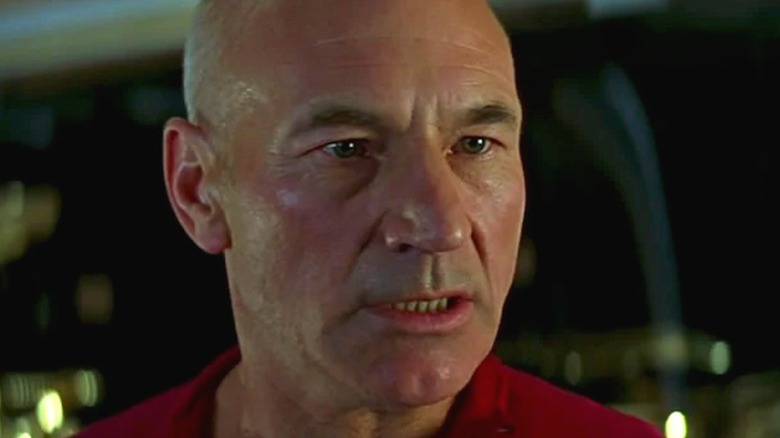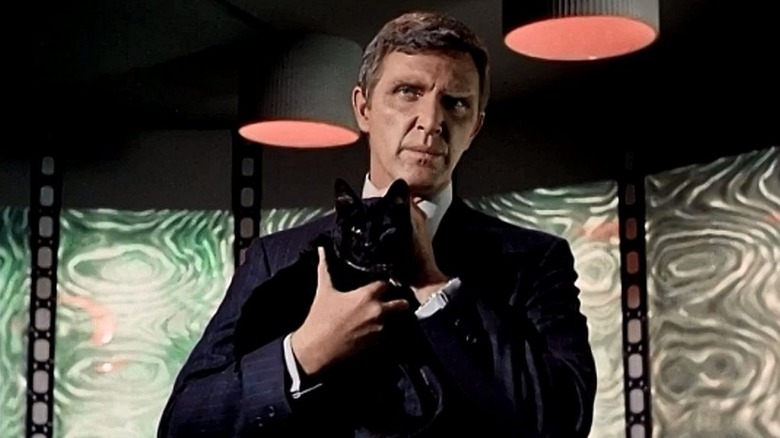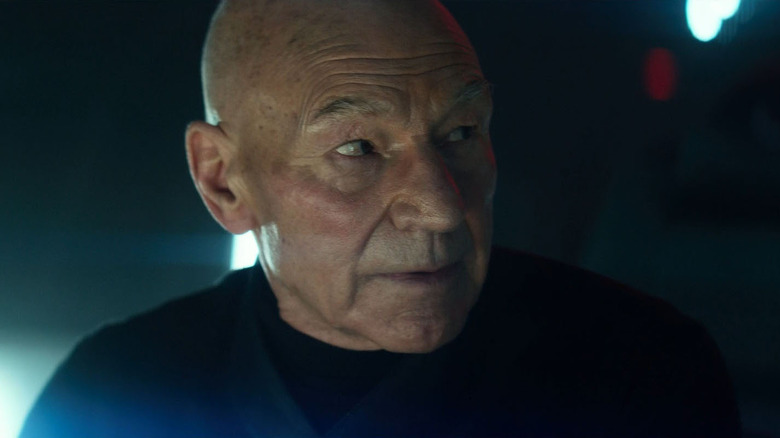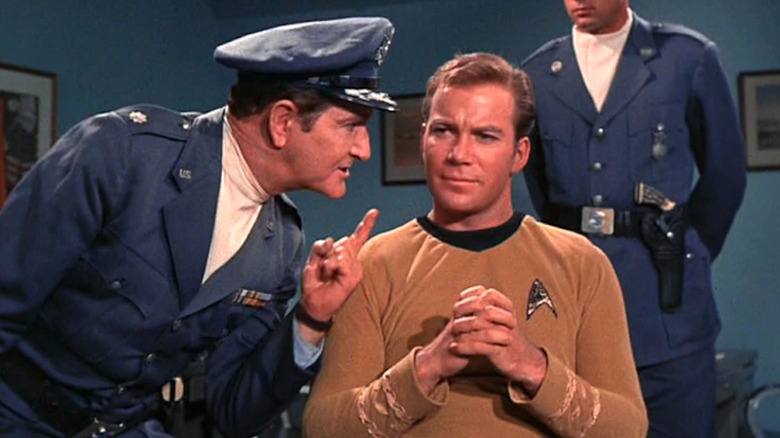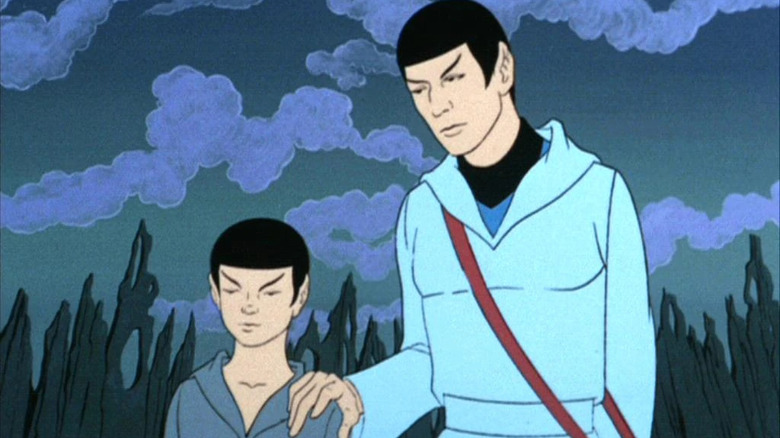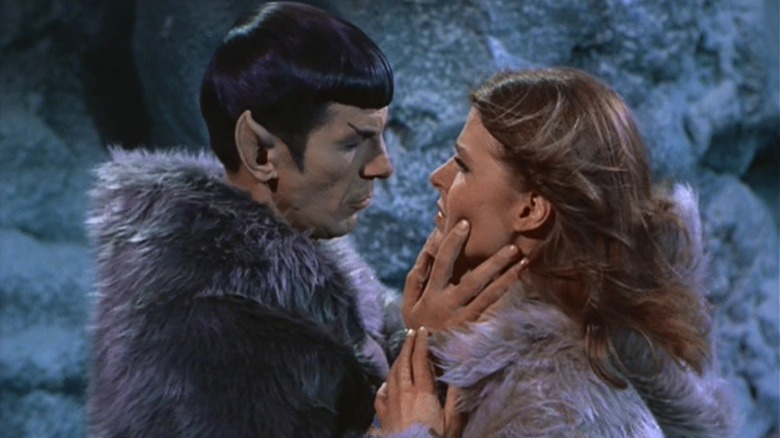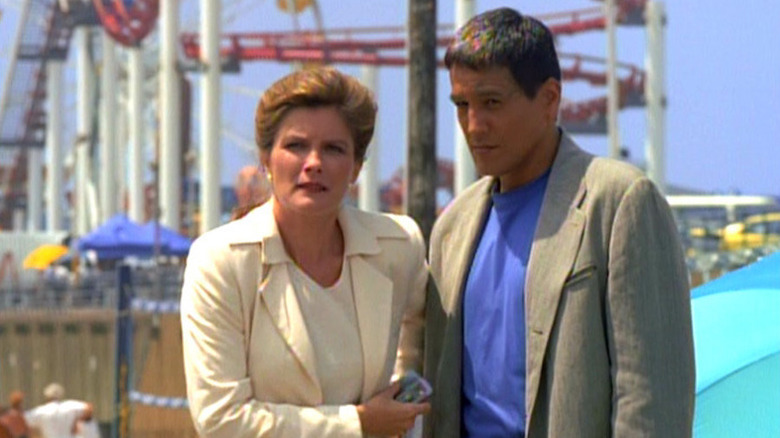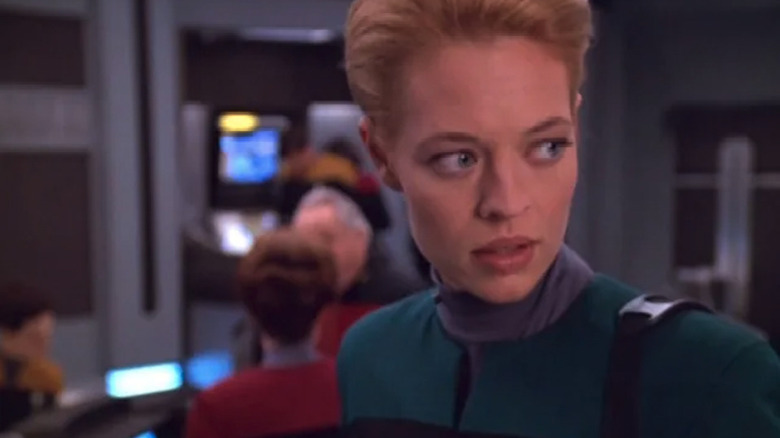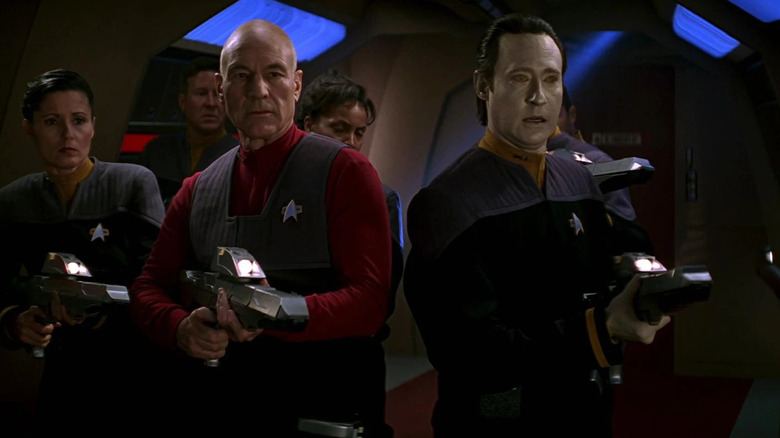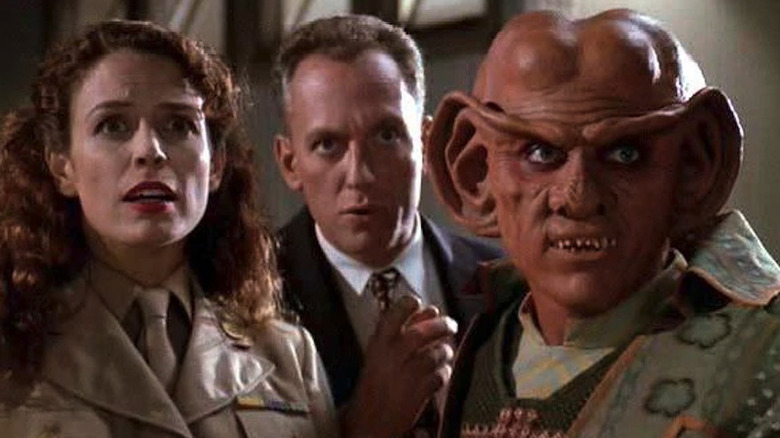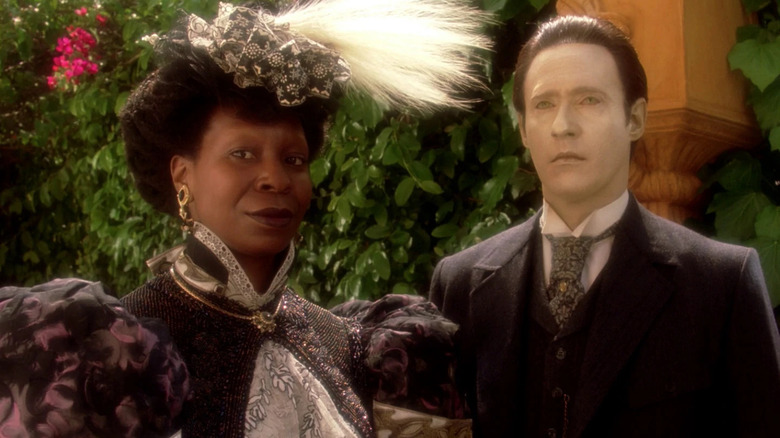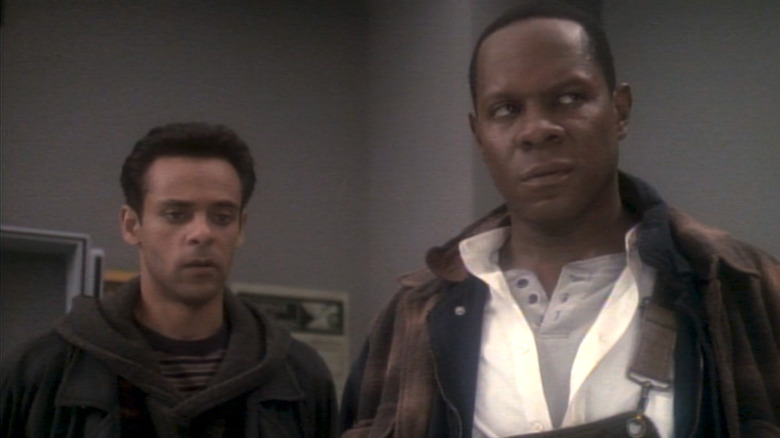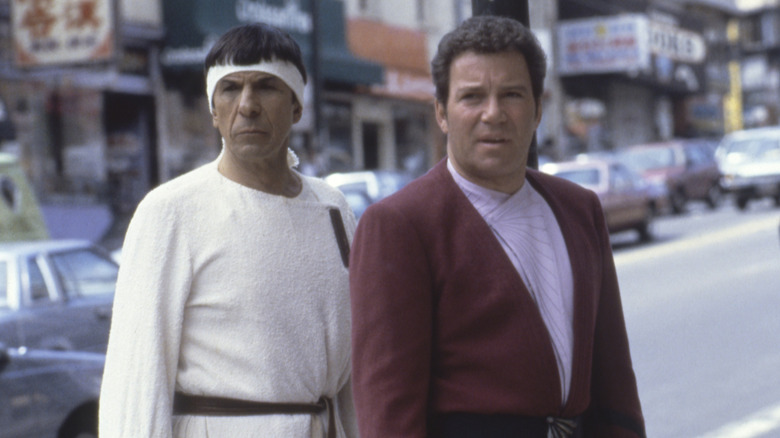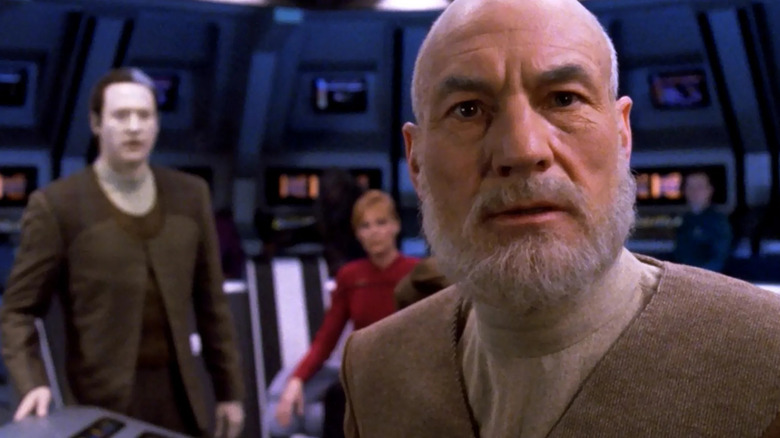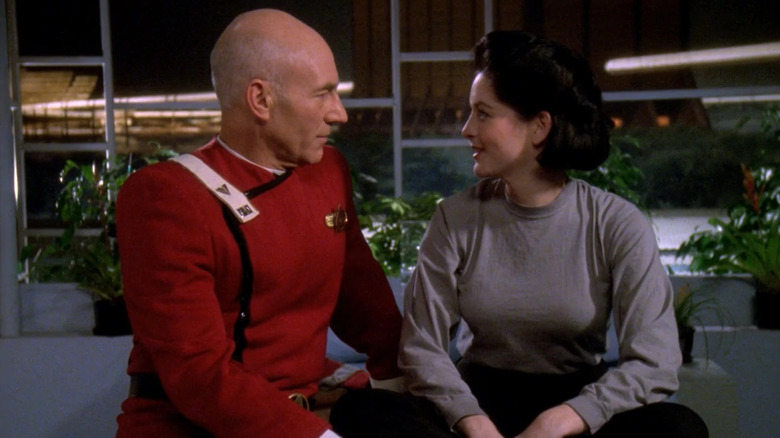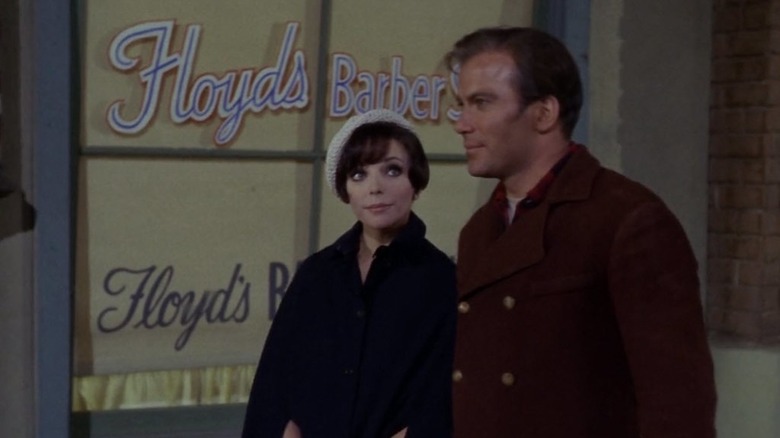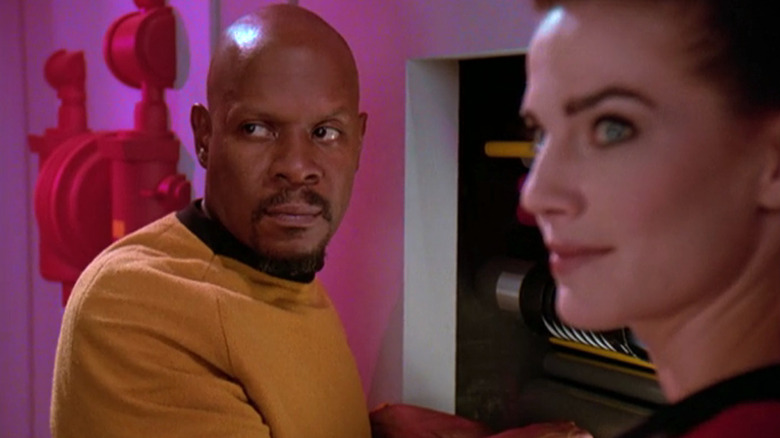The Best Time Travel Stories In Star Trek Ranked
"Star Trek" is one of the most popular science fiction franchises for a good reason, as it explores all kinds of stories across its many series and films. However, since the very beginning, one type of story has always stood out, and episodes that revolve around this concept are often among the series' best. These are stories that send their characters hurtling through time, changing history, or getting a glimpse into a far-off future, which are often filled with everything science fiction fans love, from imaginative fantasy to explorations of how our past so vividly affects our future.
When our heroes are sent back in time, they're often tasked with repairing a damaged timeline. On other occasions, "Star Trek" uses time travel to show us how even our smallest mistakes can have lasting consequences. Sometimes they illustrate the broad implications of a single act and how one change can alter the destiny of millions. However, occasionally it is used to explore a single character and their personal journey through life.
There have been plenty of episodes that messed with time, but we're sticking with the stories that sent Starfleet's finest crews back years into the past or into the far future to glimpse what could be. From a small screen trip to 1930 to a big-screen adventure that sent the Enterprise into its own historical past, these are the best time travel stories in "Star Trek" ranked worst to best.
16. Assignment: Earth (The Original Series)
"Assignment: Earth," famously drafted as a test for a proposed spinoff series, saw the Enterprise travel back to the then-present day of 1968 for scientific research. They're curious how humans managed to survive such a perilous time as the 1960s, rife with conflicts hot and cold. However, when they arrive they do more than just observe after they detect a futuristic transporter beam directed at primitive 20th century Earth.
When the crew intercepts the transport, they encounter a mysterious agent called Gary Seven, who claims to be a "Supervisor" with knowledge of the past and future who is on Earth to ensure the proper flow of history. We soon learn that the United States government is on the verge of launching a nuclear weapons platform into orbit as a new kind of space-based defense system in response to a rival power that has done the same. Having seen this sort of maneuvering on other worlds lead to disaster, Gary Seven's fellow supervisors are sent to intervene, only to go missing. Now it's up to him — with the help of Kirk and the Enterprise — to avert disaster.
Guest-starring Teri Garr as Gary Seven's assistant, "Assignment: Earth" never became a series, but it did become a "Star Trek" classic.
15. Star Trek: Picard Season 2
Following star Patrick Stewart's surprise return to his most iconic role, "Star Trek: Picard" came back for a second season in 2022 with a new showrunner in Terry Matalas, per The Wrap, and an all-new season-long storyline. The season begins with the unexpected arrival of the Borg, who come bearing a stunning request to join the United Federation of Planets. However, when Admiral Picard leads a fleet to confront them, his old nemesis Q alters history and reality is changed into a totalitarian nightmare.
Realizing that Q has changed the past, Picard, Seven of Nine, Raffi, Rios, and Jurati set out to fix the timeline, using a captured Borg Queen to travel back nearly 400 years to 2024. There Picard reconnects with a version of Guinan who doesn't recognize him and an other-worldly supervisor named Tallinn who helps him ensure that his ancestor, astronaut Renee Picard, fulfills her fateful spaceflight to Europa. Along the way, Picard must confront traumatic memories of his childhood that have haunted him all his life while Seven and Raffi fight to stop the Borg Queen from creating a new cyborg master race in the past. All the while, an ancestor of Data's creator sets out to stop them.
Stuffed with Easter eggs and franchise lore, the story's time travel elements are some of the season's best, and they offer plenty of social commentary in classic "Star Trek" fashion.
14. Tomorrow is Yesterday (The Original Series)
Mistakenly sent into the past by a deep-space phenomenon, Captain Kirk and the Enterprise arrive in 1969 amid America's space race and Cold War with the Soviet Union. However, their ship is detected by terrestrial radar, and the U.S. military sends a fighter jet to intercept them. Kirk's attempt to stop the fighter critically damages the plane, and he's forced to beam the pilot aboard to save his life. Initially hesitant to send the pilot back to Earth now that he has knowledge of the Enterprise, Spock then learns that the man's son will play a key role in Earth's history, and keeping him on board would threaten to unravel the timeline.
Kirk is faced with an impossible dilemma: how can the ship ensure the pilot's future while also not endangering the timeline by exposing the presence of the Enterprise? A classic "Star Trek" adventure that requires a clever solution, "Tomorrow is Yesterday" helped to cement time travel stories as one of the best "Star Trek" tropes.
13. Yesteryear (The Animated Series)
The short-lived "Star Trek: The Animated Series" was not often celebrated for its complex, nuanced storytelling but did manage to produce a few standout stories amidst its goofier fare. The best of these episodes just might be the time travel story "Yesteryear." Written by "The Original Series" screenwriter Dorothy "D.C." Fontana, the episode recounts Spock's youth, providing a rare glimpse into the childhood of one of the franchise's most popular characters. While visiting the Guardian of Forever to observe historical events for scientific research, Spock learns that he has somehow been erased from history and replaced by an Andorian first officer.
To restore his existence in the timeline, Spock must return to his past, where he meets a younger version of himself. Posing as a family friend named Selek, it is now his destiny to ensure that the younger Spock survives his ritual Vulcan rite of kahs-wan, where he is sent into the mountains to survive as a test of endurance. A touching story that explores Spock's inner battle to overcome self-doubt, "Yesteryear" gives new insight into his lifelong struggle to be accepted as a half-human, half-Vulcan Starfleet officer. It also remains one of the rare episodes of "The Animated Series" to be considered canon, as Dorothy Fontana explained to Trek Movie.
12. All Our Yesterdays (The Original Series)
An episode that explores the key triumvirate of Kirk, Spock, and McCoy, "All Our Yesterdays" sees the Enterprise visit a dying world with a lone survivor, Dr. Atoz. The weary scientist says all of his people have fled and introduces them to his time portal, the Atavachron. When a cry for help emerges from within, Kirk jumps through, with Spock and McCoy not far behind him. The Enterprise's captain finds himself in something like Earth's middle ages, where he's accused of witchcraft. While on trial, he learns that the people of this world have fled its destruction by escaping through the Atavachron to live in their world's distant past.
While Kirk faces medieval justice, Spock and McCoy wind up trapped thousands of years earlier, during the planet's distant ice age. There they meet a lone woman who is desperate for their company. However, the journey back in time has reverted Spock to his more barbaric Vulcan roots, and he becomes increasingly belligerent toward McCoy and falls in love with the woman. The woman, meanwhile, attempts to keep them from returning to their own time, but it soon becomes clear that if they don't get back soon, they will quickly die in the past.
11. Future's End (Voyager)
The two-part third season "Star Trek: Voyager" story "Future's End" begins with the arrival of Captain Braxton in his futuristic Federation timeship, who blames Janeway for a disaster in the 29th century. His attempt to wipe Voyager from the timeline sends the ship back to 1996, the same year the episode aired. The crew goes undercover in Los Angeles to find Braxton and make their way back to the future.
They soon discover that Braxton's timeship actually arrived years earlier and has fallen into the hands of tech guru Henry Starling (Ed Begley Jr.), who has spent decades reverse engineering its technology to build his computer empire ChronoWerx Industries. Janeway and the crew must find Braxton and get his ship back from Starling to return to the 24th century. To accomplish this, they need help from a young astronomer with the hots for Lt. Paris (Sarah Silverman). But Starling isn't about to go quietly and threatens to capture Voyager and steal its technology as well.
This fun time travel adventure is also the story that gifted the Doctor with his mobile emitter, a little piece of 29th-century technology that allowed him to leave the confines of sickbay for the first time.
10. Relativity (Voyager)
Two years after their first encounter with Captain Braxton, Janeway's starship is once again the center of the time traveling conspiracy, with Braxton recruiting Seven of Nine to travel back and stop a shadowy villain from destroying Voyager. Sent back several years, Seven of Nine finds herself aboard Voyager before she was a member of her crew, looking for a bomb planted by a terrifying time terrorist. After a failed first attempt leaves Seven dead, a second version of the former Borg drone is plucked out of the timestream and sent back to try again.
This time, Janeway in the past discovers Seven from the future, endangering their mission. Against Braxton's orders, Seven boldly enlists the aid of a disbelieving Captain Janeway, who joins her in tracking the weapon and locating the mystery man who wants them all dead. But when they find him, it's not a Hirogen hunter or a Vidiian mercenary but Captain Braxton himself. A mind-bending tale of twisted time, "Relativity" will leave your head spinning with temporal paradoxes.
9. Star Trek: First Contact
After the "Star Trek: Generations" film teamed Captain Kirk with Picard to pass the baton to the crew of "Star Trek: The Next Generation," the 1996 sequel "Star Trek: First Contact" launched the Enteprise-E in a time travel adventure for the new crew alone. The movie opens with a Borg invasion of Earth, and a massive Federation fleet assembled to stop the single cube that's on a direct course for Earth. Captain Picard and the Enterprise arrive and take charge, but it's too late. A Borg vessel has created a spatial vortex and escaped into the past, altering history, and turning Earth into a planet populated by Borg.
Following them back in time in the hopes of fixing the timeline, the Enterprise arrives in 2063 and discovers that the Borg are attempting to stop humanity's first warp-capable starship from launching, preventing the formation of the Federation itself. Riker, Troi, and Geordi head to the surface to help history's greatest inventor, Zephram Cochrane, repair and launch his primitive starship. Meanwhile. Picard, Data, Doctor Crusher, and Lily — a woman from the 21st century trapped on the Enterprise — must fend off a growing Borg invasion force who are attempting to assimilate the ship.
A pulse-pounding, suspenseful, quasi-horror movie that depicts the Borg as a zombie-like horde with a diabolical queen, "First Contact" is the biggest "Star Trek" time travel story and the high point of the "The Next Generation era" films.
8. Little Green Men (Deep Space Nine)
"Star Trek: Deep Space Nine" is often viewed as the darker '90s spinoff series, but it also embraced humor far more than "The Next Generation," "Voyager," or "Enterprise." One such comedic jaunt was the fourth season time travel adventure "Little Green Men" that starred the station's gaggle of oddballs, Ferengis Quark, Rom, and Nog. In the episode, beleaguered bartender Quark finally receives the shuttle his cousin Gaila has been promising him for years, and he offers to take his nephew Nog to Earth — where Nog has been accepted to Starfleet Academy — for its maiden voyage. Together with his brother Rom, the large-lobed trio gets to Earth only to find that Gaila has sabotaged the ship, and Rom's desperate bid to stave off destruction sends them hurtling back 400 years to Earth's distant past.
Landing in Roswell, New Mexico, we realize that the UFO that legend says landed there wasn't from Mars but was from the 24th century, and instead of big-headed grey aliens, it was carrying three Ferengi. Mistaken for alien invaders planning Earth's conquest, Quark quickly hatches a plan to profit off the mistaken time travel visit, but the military wants them imprisoned and tortured. Thankfully, a mysterious stowaway is revealed to be Constable Odo, and with the help of a pair of sympathetic government agents, the Ferengi time travelers just might be able to make it home without changing history.
7. Time's Arrow (The Next Generation)
The only time travel story to serve as a season-ending cliffhanger is the fifth season finale of "Star Trek: The Next Generation," which opens with a stunning reveal as Data's severed head is discovered in a cave buried underneath San Francisco. Even stranger, it's apparently been there for more than five centuries. Realizing that Data may be doomed to die in the past, Picard tries to keep his second officer safe when the investigation leads them to a mysterious planet where they discover a race of shape-shifting energy beings traveling back to 19th century Earth. Unfortunately, Data is soon swallowed up by the aliens' vortex and deposited in 1893, where he finds none other than the Enterprise's bartender Guinan, who has been living as a human on Earth during that period.
Stuck in the 19th century, Data gets Guinan's help foiling the deadly alien plot, as the shapeshifters are kidnapping and feeding off the lifeforce of humans in the past. However, their mission runs them afoul of prominent public figure Samuel Clemens, better known as Mark Twain. Pursued by the curious author who believes they're up to no good, Data is soon joined by Picard and the rest of the crew, who've followed him back in time. Now they'll have to stop an alien invasion while trying not to alter history in the process.
6. Past Tense (Deep Space Nine)
In the third season two-part effort "Past Tense," Commander Sisko, Dr. Bashir, and Lt. Dax are hurled back in time to 2024, which was then still some 30 in the future when the episode aired in 1995. Materializing in San Francisco after a transporter accident, Sisko and Bashir are trapped in a "Sanctuary District," a dystopian homeless encampment. Things get more complicated when they inadvertently get a man killed who just so happens to be an iconic revolutionary destined to lead a political revolt that will prove vital to Earth's past.
Taking his place to ensure that history plays out as it should, Sisko — as citizen freedom-fighter Gabriel Bell — must lead an uprising in the Sanctuary District. However, Bashir points out that according to the history books, Bell was killed in the riots, and Sisko may have to sacrifice his life to save the timeline. Meanwhile, Dax is rescued by a wealthy and charismatic media magnate, who, with her help, realizes that what he thought was a 21st-century utopia may be anything but.
A frightening portent of a future eerily similar to what we see today, "Past Tense" is rife with social and political allegory. Another towering performance from series star Avery Brooks punctuates one of the most prescient and powerful episodes of the series.
5. Star Trek IV: The Voyage Home
Though not the highest-rated film in the franchise, "Star Trek IV: The Voyage Home" is perhaps the most popular and fondly remembered by wider audiences. Released in 1986, it directly followed the events of "Star Trek III: The Search for Spock," with Captain Kirk and his crew aboard a Klingon Bird of Prey on their way back to Earth after bringing Spock back to life. When they arrive, they discover a sinister alien probe that threatens the planet and determine that it is attempting to communicate with humpback whales — who went extinct long ago. To save the world, Kirk must take his crew back in time to 1986 to retrieve a pair of whales in the hopes that they can communicate with the probe and avert disaster.
Once back in the audience's present-day, however, Kirk and his crew find themselves in unfamiliar territory. This fish out of water time travel story splits the crew into teams. Kirk and Spock are sent to a marine exhibit to find a pair of whales, McCoy and Scotty head to an industrial plant to create a home for the maritime mammals, while Uhura and Checkov head to the aircraft carrier Enterprise to steal a power source to repair their ship.
A classic '80s caper, "The Voyage Home" is a sci-fi comedy that delivers some of the franchise's most iconic movie moments.
4. All Good Things (The Next Generation)
The series finale of "Star Trek: The Next Generation" was the perfect bookend to seven seasons of stories that sends Captain Picard barreling back and forth through time. After being visited by the immortal trickster Q, Picard finds all of humanity threatened with annihilation and must use his experiences in three different time periods to track down the cause. First he travels seven years into the past, on the day he took command of the Enterprise, where an untested crew is pushed to its limit by a new captain they hardly know.
Picard is also sent some 25 years into the future where he's a deteriorating old man who must reunite his old crew to save humanity. However, in the future he no longer commands the respect of his former friends, who view him as a doddering fool suffering from memory loss. If he can't convince his crews in the future and in the past to work together with his crew in the present, all of mankind may be doomed.
A perfect series ender, "All Good Things" sends viewers on an epic journey through time. Tying in to the series' very first episode, "All Good Things" puts Picard on trial one more time by the god-like Q in what would be remembered as one of the show's best episodes.
3. Tapesty (The Next Generation)
In another Q episode, "Tapestry" opens with the shocking death of Captain Picard, who is killed by an energy blast to the chest. Told by Q that he can go back and change his past, he's offered the opportunity to change an event from his youth that he's always regretted: a violent incident when he was fresh out of Starfleet Academy that resulted in his need for an artificial heart. With a snap of Q's fingers, Picard finds himself back at Starbase Earhart in his early 20s, having magically been transported some 30 years into the past. Assured that any changes in the timeline will affect only him, Picard endeavors to make his life a better one.
In attempting to avert a violent confrontation with a group of vicious Nausicaans, Picard inadvertently upsets Cory, his closest friend, and spends the night with a young woman he regretted never pursuing. He avoids the brawl but destroys two friendships, and when he's brought back into the present — very much alive — he is no longer captain of the Enterprise but a junior lieutenant. In his attempt to fix his mistakes, Q has taught him that even our most shameful moments can help shape us into better people.
In "Tapestry," time travel is used to help Captain Picard learn to appreciate life and the person his troubled youth helped him become.
2. The City on the Edge of Forever (The Original Series)
In what is often ranked as the very best episode of "Star Trek: The Original Series," the time travel romance "The City on the Edge of Forever" sees the Enterprise visit a planet that is home to a bizarre cosmic being known as the Guardian of Forever, a sentient gateway that peers into the past and future. When McCoy is driven mad thanks to an accidental overdose of cordrazine, he hurls himself through the gateway and lands in 1930 New York City. Instantly, all of history is altered and the United Federation Of Planets no longer exists. Kirk and Spock realize that McCoy must have somehow changed the past and follow him to repair the damage.
When Kirk and Spock arrive, they take refuge in a homeless shelter run by a young woman named Edith Keeler. While they attempt to locate McCoy and prevent him from altering the timeline, Kirk and Edith fall in love. However, Kirk is heartbroken when Spock traces the historical change to the death of Keeler, who is destined to die in a traffic accident that McCoy will save her from. In a nearly Shakespearean sci-fi tragedy, Kirk is forced to stop his friend from saving the woman he loves to restore the timeline and save all of human history.
1. Trials and Tribble-Ations (Deep Space Nine)
Produced to coincide with the franchise's 30th anniversary in 1996, the "Star Trek: Deep Space Nine" episode "Trials and Tribble-ations" is a love letter to "Star Trek: The Original Series." It begins aboard the Defiant, where a human refugee rescued from Cardassia is being ferried home but steals access to the Bajoran Orb of time and bolts backward more than a hundred years, changing the course of the past. It's up to Sisko and his crew to fix history when they learn that the refugee was actually Arne Darvin, a Klingon in disguise who had caused trouble for Captain Kirk some decades before.
Following him back a century, Sisko and his crew go undercover aboard the original Enterprise to thwart Darvin's plan to kill Captain Kirk. The episode cleverly mixes archival footage with new scenes and uses "Forrest Gump" techniques to put Sisko, Bashir, Dax, and the rest into the scenes aboard the Enterprise, even interacting with Captain Kirk. A joyously fun escapade, it faithfully recreates the original Enterprise, its costumes, and props while fully embracing the silliness of its premise. By dropping the crew of "Deep Space Nine" into a beloved "Star Trek" episode, it became itself one of the most celebrated installments in the franchise.
